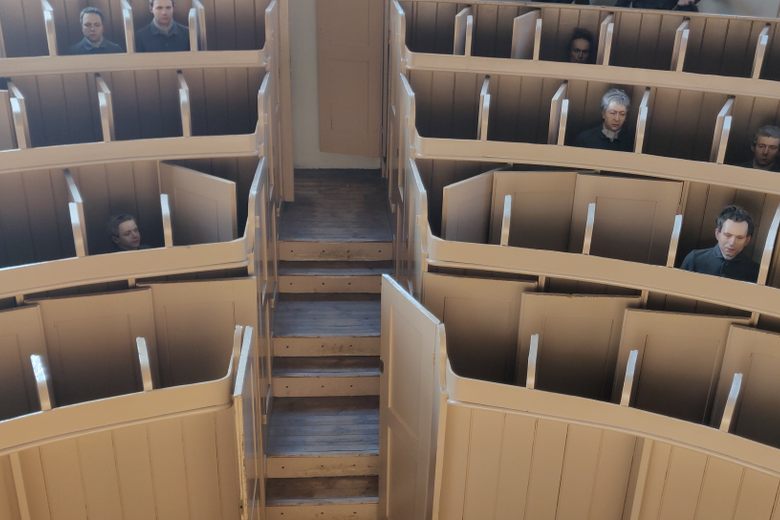Introduction
The Prison Chapel at Lincoln Castle is a remarkable historical and architectural feature, embodying the intersection of penal reform and religious observance in 19th-century England. Situated within the walls of Lincoln Castle, a site with a rich history dating back to the Norman Conquest, the chapel provides a unique lens through which to explore Victorian penal practices and the evolving philosophies of criminal justice. This essay delves into the historical context, architectural features, and significance of the Prison Chapel, highlighting its role in the broader narrative of incarceration and reform.
Historical Context of Lincoln Castle and the Prison Chapel
Lincoln Castle, constructed in 1068 by William the Conqueror, has served various functions over the centuries, including as a military fortress, administrative center, and prison. By the 18th century, the castle was repurposed as a penal facility, reflecting the broader trend of using historical structures for new purposes as part of England’s evolving penal system.
The Prison Chapel was built in the early 19th century during a period of significant reform in the British penal system. This era was marked by a shift from public, punitive measures towards a more rehabilitative approach to imprisonment. Influential reformers such as John Howard and Jeremy Bentham advocated for improved conditions and the use of solitary confinement as a means of moral reform. The separate system, which emphasized isolation and reflection, became a cornerstone of this reform movement.
The construction of the Prison Chapel was part of a broader effort to integrate religious observance into the penal system, reflecting the belief that spiritual guidance could aid in the moral reformation of inmates. The chapel was designed to provide a space for prisoners to attend religious services, thus reinforcing the penitentiary ethos of the era.
Architectural Features of the Prison Chapel
The Prison Chapel at Lincoln Castle is notable for its distinctive architectural features, which reflect both its functional role within the prison and its symbolic significance.
1. Design and Layout
The chapel was designed to accommodate the separate system of imprisonment, which emphasized isolation. Consequently, the chapel’s layout is characterized by its individual cubicles or stalls, which allowed prisoners to attend services without interacting with one another. This design was intended to maintain the principle of solitude while providing inmates with the opportunity for spiritual reflection and guidance.
The chapel features a central aisle with pews arranged along the sides. These pews are divided by partitions that create individual stalls, ensuring that prisoners could engage in worship without seeing or communicating with one another. This arrangement was in line with the broader principles of the separate system, which sought to isolate inmates as much as possible.
The altar is situated at the front of the chapel, where it is prominently visible to all inmates during services. The design emphasizes the centrality of religious observance in the prison’s regime and reflects the belief that spiritual reform was an essential component of the rehabilitation process.
2. Architectural Style
The architectural style of the Prison Chapel is indicative of the early 19th-century Gothic Revival movement, which sought to revive medieval architectural forms and ideals. The chapel’s design features pointed arches, ribbed vaults, and intricate stone carvings that evoke the grandeur of medieval church architecture. This style was chosen to create an atmosphere of solemnity and reverence, reinforcing the chapel’s role as a space for spiritual reflection.
The use of Gothic Revival elements also served to align the prison’s architecture with contemporary trends in religious and institutional design. The style was intended to inspire a sense of awe and encourage inmates to reflect on their moral and spiritual lives.
3. Interior Decoration
The interior decoration of the Prison Chapel is relatively simple but effective in creating a contemplative environment. The walls are adorned with plain, unadorned stone, and the seating is functional, designed to accommodate the needs of the prison’s occupants rather than to impress with opulence. The focus is on creating a space conducive to worship and reflection, rather than on elaborate decoration.
The stained glass windows, if present, would have been designed to let in natural light while maintaining the privacy of the inmates. The use of stained glass was a common feature in Gothic Revival architecture, serving both aesthetic and functional purposes.
The Role of the Prison Chapel in Penal Reform
The Prison Chapel played a crucial role in the broader context of Victorian penal reform. The integration of religious observance into the prison regime was based on the belief that spiritual guidance could aid in the moral reformation of inmates. This approach was rooted in the idea that penitence, prayer, and reflection could help prisoners come to terms with their crimes and reintegrate into society as reformed individuals.
The separate system, which was implemented in many Victorian prisons, emphasized isolation and self-reflection. The Prison Chapel was designed to support this system by providing a dedicated space for religious services, where inmates could engage in individual worship and contemplation. The chapel was intended to reinforce the principles of the separate system and to provide inmates with an opportunity for spiritual growth.
The presence of a chapel within the prison also reflected the broader societal belief in the importance of religious reform as a component of criminal justice. The integration of religious observance into the penal system was seen as a means of addressing the moral and spiritual needs of prisoners, alongside the more practical aspects of rehabilitation and discipline.
Preservation and Modern Significance
Today, the Prison Chapel at Lincoln Castle stands as a well-preserved example of Victorian penal architecture and reform. The chapel is part of the broader Lincoln Castle complex, which has been carefully restored and maintained by English Heritage. The preservation of the chapel provides valuable insights into the history of the British penal system and the evolving philosophies of incarceration and rehabilitation.
The chapel is now open to the public, offering visitors the opportunity to explore its historical and architectural features. Guided tours, educational programs, and interactive exhibits provide context on the role of the chapel within the prison system and the broader history of penal reform. The preservation of the chapel allows for a deeper understanding of the principles that guided the development of the Victorian penal system and their impact on the lives of inmates.
In addition to its historical significance, the Prison Chapel continues to serve as a symbol of the ongoing dialogue about criminal justice and rehabilitation. The principles of the separate system and the role of religious observance in the penal system are topics of ongoing interest and debate, and the chapel’s preservation ensures that these discussions remain grounded in historical context.
Conclusion
The Prison Chapel at Lincoln Castle is a remarkable historical and architectural feature that provides valuable insights into the Victorian penal system and the philosophy of rehabilitation. Its design, reflecting the principles of the separate system, and its role in the broader context of penal reform, highlight the significance of religious observance in the prison regime. The preservation of the chapel allows for a deeper understanding of the history of incarceration and the evolving philosophies of criminal justice.
As a well-preserved example of Victorian penal architecture, the Prison Chapel at Lincoln Castle offers visitors a unique opportunity to explore the intersection of law, religion, and reform. Its continued relevance in discussions about criminal justice and rehabilitation underscores the enduring impact of the principles it represents. The chapel stands as a testament to the complex history of imprisonment and the ongoing quest for justice and moral reform in the penal system.



